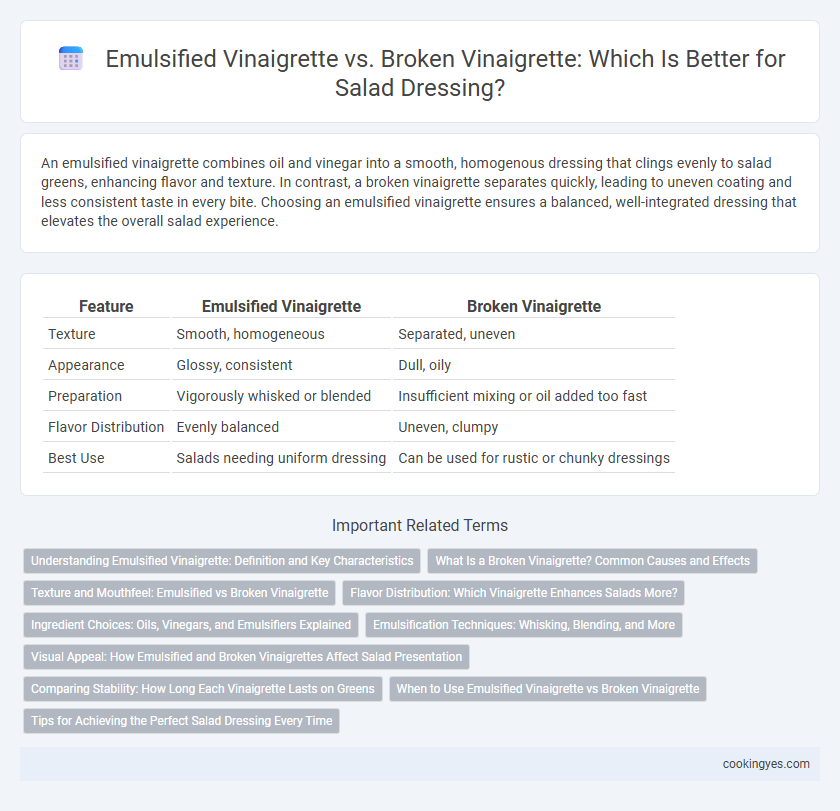An emulsified vinaigrette combines oil and vinegar into a smooth, homogenous dressing that clings evenly to salad greens, enhancing flavor and texture. In contrast, a broken vinaigrette separates quickly, leading to uneven coating and less consistent taste in every bite. Choosing an emulsified vinaigrette ensures a balanced, well-integrated dressing that elevates the overall salad experience.
Table of Comparison
| Feature | Emulsified Vinaigrette | Broken Vinaigrette |
|---|---|---|
| Texture | Smooth, homogeneous | Separated, uneven |
| Appearance | Glossy, consistent | Dull, oily |
| Preparation | Vigorously whisked or blended | Insufficient mixing or oil added too fast |
| Flavor Distribution | Evenly balanced | Uneven, clumpy |
| Best Use | Salads needing uniform dressing | Can be used for rustic or chunky dressings |
Understanding Emulsified Vinaigrette: Definition and Key Characteristics
Emulsified vinaigrette is a stable mixture where oil and vinegar are combined into a smooth, homogeneous dressing through the use of emulsifiers like mustard or egg yolk, preventing separation. This type of vinaigrette clings evenly to salad leaves, enhancing flavor distribution and texture. Key characteristics include a creamy appearance, consistent viscosity, and the ability to maintain its emulsified state over time without separating into layers.
What Is a Broken Vinaigrette? Common Causes and Effects
A broken vinaigrette occurs when oil and vinegar separate instead of forming a smooth, cohesive dressing, often caused by improper mixing, cold ingredients, or the absence of an emulsifying agent like mustard. This separation results in uneven coating on salad greens, diminishing flavor distribution and texture consistency. Understanding these common causes helps in achieving a perfectly emulsified vinaigrette for optimal salad dressing performance.
Texture and Mouthfeel: Emulsified vs Broken Vinaigrette
Emulsified vinaigrette boasts a smooth, creamy texture that evenly coats salad greens, enhancing each bite with a balanced mouthfeel. Broken vinaigrette, by contrast, separates oils and acids, resulting in a thinner, uneven coating that often feels greasy or inconsistent on the palate. The stable emulsion creates a harmonious blend of flavors and textures, while broken dressings can detract from the salad's overall sensory experience.
Flavor Distribution: Which Vinaigrette Enhances Salads More?
Emulsified vinaigrette creates a smooth, homogeneous mixture that evenly coats salad leaves, ensuring consistent flavor distribution with every bite. Broken vinaigrette, lacking stable suspension, results in uneven dressing application, causing some salad parts to be oversaturated while others remain bland. For enhancing salads, emulsified vinaigrette optimizes flavor balance and texture, making it superior for uniform taste enhancement.
Ingredient Choices: Oils, Vinegars, and Emulsifiers Explained
Emulsified vinaigrette combines oil and vinegar into a smooth, stable dressing using emulsifiers like mustard or egg yolk, ensuring consistent flavor and texture in salads. Broken vinaigrette occurs when the oil and vinegar separate, often due to improper mixing or the absence of effective emulsifiers, resulting in uneven coating and taste. Selecting high-quality oils such as extra virgin olive oil, vinegars like balsamic or apple cider, and natural emulsifiers is crucial for achieving the desired consistency and enhanced flavor in salad dressings.
Emulsification Techniques: Whisking, Blending, and More
Emulsified vinaigrettes create a stable mixture by thoroughly combining oil and vinegar using techniques like whisking, blending, or shaking, ensuring a smooth and consistent texture that clings well to salad leaves. Whisking manually incorporates tiny oil droplets into the vinegar or acid base, while blending uses high-speed blades to form a finer emulsion with enhanced stability. These emulsification methods prevent vinaigrettes from breaking, which occurs when oil separates, resulting in a less appealing, uneven dressing consistency.
Visual Appeal: How Emulsified and Broken Vinaigrettes Affect Salad Presentation
Emulsified vinaigrettes create a smooth, homogeneous dressing that evenly coats salad leaves, enhancing the visual appeal with a glossy, consistent finish. Broken vinaigrettes separate oil and vinegar, often leaving patchy, uneven spots that can make the salad look less appetizing and messy. The stable texture of emulsified vinaigrettes helps maintain an attractive presentation, while broken versions struggle to hold a cohesive appearance on the salad surface.
Comparing Stability: How Long Each Vinaigrette Lasts on Greens
Emulsified vinaigrette, composed of oil and vinegar thoroughly blended with an emulsifier like mustard, creates a stable mixture that adheres evenly to salad greens and maintains its consistency for hours without separation. In contrast, broken vinaigrette lacks proper emulsification, causing oil and vinegar to separate quickly, resulting in uneven dressing distribution and faster wilting of greens due to inconsistent coating. The stability and longevity of emulsified vinaigrette make it superior for maintaining freshness and flavor on salads over time.
When to Use Emulsified Vinaigrette vs Broken Vinaigrette
Use emulsified vinaigrette when you want a smooth, creamy texture that evenly coats salad greens, ensuring balanced flavor and a consistent mouthfeel. Broken vinaigrette, with its separated oil and vinegar layers, is best for rustic, hearty salads where a more pronounced oil flavor and varied texture are desired. Choose emulsified dressings for delicate salads like mixed greens or arugula, and broken vinaigrettes for robust ingredients such as roasted vegetables or grain bowls.
Tips for Achieving the Perfect Salad Dressing Every Time
Achieving the perfect salad dressing requires understanding the difference between emulsified and broken vinaigrette; emulsified vinaigrettes blend oil and vinegar into a smooth, cohesive mixture using a whisk or blender, while broken vinaigrettes separate, with oil floating atop vinegar. To maintain emulsification, use an egg yolk or mustard as a natural emulsifier and add oil slowly while whisking vigorously. Store dressings in airtight containers and shake well before each use to ensure consistent texture and flavor balance in every salad.
Emulsified vinaigrette vs broken vinaigrette for salad dressing Infographic

 cookingyes.com
cookingyes.com